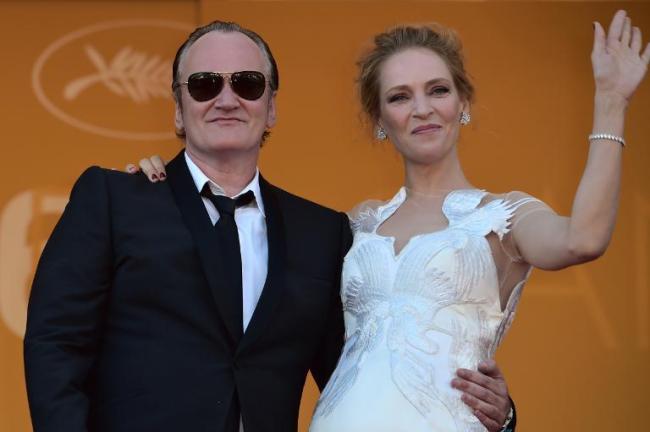PARIS (AFP) ― Director Quentin Tarantino lambastes digital film-making as nothing less than the “death of cinema as I know it.”
Converts hail it as a democratizing force for good that is cheaper and faster than celluloid.
A debate is raging in the film world about the merits of shooting movies on 35 mm film versus digital cameras.
In one corner are those who believe digital’s practical and economic benefits make it impossible to resist.
In the other, “purists” such as Tarantino and “The Dark Knight Rises” director Christopher Nolan who cherish the visual “texture” of 35 mm and warn that something important is being lost.
 |
U.S. director Quentin Tarantino, who says digital film-making spells the death of traditional cinema, poses with actress Uma Thurman at the Cannes Film Festival on May 24, 2014. (AFP) |
“The fact that most films now are not presented in 35 mm means that the war is lost,” Tarantino told the Cannes Film Festival last month, describing digital projections as “just television in public.”
“Apparently the whole world is OK with television in public ― but what I knew as cinema is dead!” the “Pulp Fiction” and “Kill Bill” director said.
Just ‘nostalgia’
JJ Abrams, another celluloid devotee, who has just started shooting the new “Star Wars” movie, has also warned that without 35 mm “the standard for the highest, best quality” will be lost.
Nolan, meanwhile, predicts that studios will allow 35 mm to completely disappear unless directors insist on it.
Alain Roulleau, whose family has run Paris’s oldest cinema since 1948, however, dismisses all this as “nostalgia” ― and points out that most studios have already stopped supplying films in 35 mm.
Located on the slopes of Montmartre, Paris’ old artists’ quarter, Studio 28 with its Jean Cocteau-designed lamps and painted red steps, has old-world charm in buckets.
In the projection room, though, Roulleau has made sure this small independent cinema is bang up to date.
Roulleau took the decision to install digital projection equipment four years ago and admits he “almost cried” when he saw the quality of the first digital images, which he described as “very icy, too perfect, with no atmosphere.”
Fortunately, he says, since then the quality has seen constant improvements and in the past year he has shown only two films in 35 mm.
“When you have a 35 mm print, when the print is quite new the image is perfect, but after two weeks in a theatre you have little dark spots on the screen from the dust,” he told AFP.
“With digital, from the first screening to the last, six months later, it’s the same quality of image,” he said.
Others stress that even movies shot in 35 mm are now quickly converted to digital for distribution and that the real clincher is the impact on the studios’ bottom line.
Printing just one film on 35 mm film and delivering it to the cinema where it will be shown can cost $1,500 alone ― compared to $150 for digital.
With a copy needed for each of several thousand cinemas, it is easy to see why digital seems to have won the day.
Patrick DiRenna, founder of the New York-based Digital Film Academy, called the shift to digital a natural evolution, adding that the lower start-up costs were allowing new voices to be heard.
Clay not marble
“The cameras are now almost completely there. The only thing that’s lacking at this point is a slight level of picture quality, but that will change and in exchange we have a democratization with artists who are now really able to do their work,” he said.
Shooting a film on a digital camera, he said, was like “sculpting in clay not marble” with directors able to keep reshaping until “you get to where you need to go.”
And he predicted that Tarantino too would eventually be won round.
“Great artists like Quentin Tarantino are generally uncomfortable when they come across something new,” he said.
“Charlie Chaplin’s discomfort with talkies is a perfect example ― but when he finally made the adjustment, he turned around and made the ‘The Great Dictator’ and his mastery showed through again,” he said.
For now, however, Tarantino shows no sign of wavering.
In Cannes, he added that he viewed the current generation of film-makers as a lost cause and lived in hope that 35mm could make a comeback.
“I’m hopeful that we’re going through a woozy, romantic period with the ease of digital,” he said.
“While this generation is completely hopeless, (I hope) that the next generation that will come up will demand the real thing ― in the way that after 20 years, albums are slowly coming back.”








